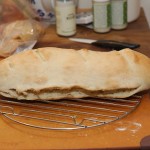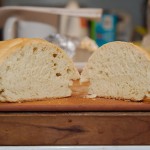I’ve never actually made bread before (I’ve made pie crust, and baked a couple of cakes, but not much baking in general). So I decided I wanted italian bread tonight.
To me, that means a white bread, somewhat freeform loaves (but tending more towards oval than circular). A tight, somewhat chewy crumb. And fairly heavy crust, though thinner and less crunchy than “French bread”.
I started from this basic recipe.
On first making it, I ended up using about 2 ¾ cups of flour. I may have left the dough slightly too moist, but not disastrously. I had to scrape it down off the sides of the bowl and off the dough hook of the mixer a couple of times, which Pamela says is normal. I didn’t feel it had risen enough in half an hour, so I gave it another half hour, and then punched it down. Rising was in the lower oven on the “proof” setting, I didn’t measure the actual temperature, but it felt reasonable.
I didn’t do anything to emphasize the crust, no basting, no pizza stone, no water pan in the oven.
Ingredients
1 envelope (¼ oz.) active dry yeast
1 tsp sugar
1 cup warm water (100° – 110°)
2 to 3 cups bread flour (I used unbleached general purpose)
2 TBS olive oil
1 tsp salt
Procedure
Combine yeast, sugar, 1 cup warm water in mixer bowl. Let stand 5 minutes (and check for yeast activity).
Add 2 cups flour, oil and salt to bowl. Beat on low (I used the lowest speed on our KitchenAid) with dough hook for 1 minute.
Gradually add up to 1 cup additional flour until dough leaves sides of bowl and polls together (dough goes through a “shaggy” stage in here). With our mixer we have to push flour into the dough hook some. Add flour until the dough is the “right” consistency, which is soft and smooth, not wet, sticky, or overly dry with a rough surface.
Increase speed to medium and beat 5 minutes (I used the second-lowest speed).
Get dough off hook and make a ball in the bottom of the bowl. Cover this closely with plastic and let rise 30 minutes in a draft-free place at about 85° (I used the bottom oven on the “proof” setting). Let rise for 30 minutes or until doubled in bulk (I ended up giving it an hour), then punch down.
Start oven preheating to 400°.
Punch down and let stand 10 minutes (I put it back in the oven under plastic).
Take dough from bowl (it may have been a bit too moist, it tried to stick just a bit) and place on lightly floured surface. Form into loaf, about 12 inches long.
Place dough on lightly greased cookie sheet
Make 3 ¼” deep scores across the top with sharp knife to let the steam out (mine had kind of crude slashes, the dough tended to stick to the knife; and steam blew out one side of the loaf).
Bake at 400° for 16 minutes or until golden brown. Should make a nice hollow sound when rapped on the bottom. (I ended up at about 20 minutes).
Cool on wire rack.
Slice and eat!
Analysis
I liked the way the bread texture came out. The crust is too thin; it even looks wrong from outside. Taste is tolerable (at least when fresh). This kind of tastes like what I think of as good bread machine results, i.e. mediocre, but fresh bread is always good.
Next time I want to try something to increase the crust, maybe painting it with water.




